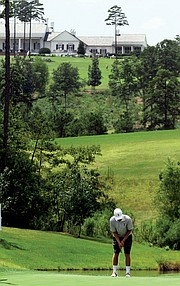The pieces of a plan to redevelop the Hotel Grim are almost all in place, and construction could begin next spring.
A key element of the plan's financing is expected to get final approval within about a month, clearing the way for a recently formed partnership to purchase the property and begin renovation work, developer Jim Sari said.
In July, Sari and Mark Bouldin formed Grimm (sic) Lofts LLC in anticipation of buying the hotel from its current owner, local attorney Billy Harrell.
Sari intends to convert the hotel's upper floors into 98 apartments, 20 of which will be priced for lower-income residents. The ground floor will be office and retail space.
"It's not a done deal, but we're closer than ever," said David Orr, director of planning and community development for the city of Texarkana, Texas.
The city has played an important role in securing three layers of the project's financing: tax credits available because of the Grim's historic status, funds from the Environmental Protection Agency and a loan from the Department of Housing and Urban Development.An application prepared by Texarkana College professor Beverly Rowe and submitted by the city earned the Grim a place on the National Register of Historic Places in May 2015. As a result, the hotel's owners are eligible for $2.4 million in Texas Historic Preservation Tax Credits and $1.8 million in federal Historic Tax Credits, Orr said.
The city's EPA Revolving Loan Fund is making $650,000 available to lend to the Grim's developers. The fund is a sum granted to the city by the EPA for the purpose of cleaning up contaminated sites. It contains $780,000 total.
Almost $1.5 million in funding for the project is expected come from HUD's Community Development Block Grant Section 108 Loan Guarantee Program. The program makes five times the amount of the city's annual CDBG allocation available to lend for development, at low interest rates.
An application for the HUD 108 loan has been approved at the regional level and is under review in Washington, D.C., Orr said. Its final approval is the last obstacle to the Grim's sale.
"They haven't approved it fully, but they've said they want to do it, and this is how you can do it, so we agreed, and we're trading paper so I expect that approval in the next 30 days, probably," Sari said.
"Once they approve, I'll start drawing plans, I'll engage my lender. I've already got the equity investors, I've got the bankers, and, you know, you've got to go through that due diligence, and then you have to get permit-ready, so that takes several months. So my guess, February or March is when we'll close."
Sari too cautioned that the deal has not been completely finalized, but he said that probably, the worst that could happen is a bureaucratic delay by either HUD or EPA, neither of which would completely stop the project.
"I feel real confident about it. I'm applying resources to it," he said.
Sari praised city officials' determination in piecing together the financing necessary to reclaim a "white elephant building" like the Grim.
"These dollars that go through HUD and EPA are cumbersome, and it takes time, and the natives get restless. Their ability to remain steadfast and not get jelly-legged in this process has been impressive to me. I don't always get that," he said, adding that the city has stepped up financially, as well.
"The city's putting their money where their mouth is," he said. "Even though it's kind of conduit money, they still have risk. They're putting in leverage at probably 15 to 20 percent. I can't remember what the numbers are, but it seems like it's 13 or 15 million, and they're putting in over 2 million. Normally, leverage from localities is 6, 8, 10 percent max."
Sari said in his experience, redeveloping a central property like the Grim can spark the revival of an entire downtown neighborhood, and he is excited to finally be so close to achieving that goal.
"I think what you'll find is that becomes a catalyst for the local citizens to come downtown and buy a building, do a loft upstairs, do a store downstairs," he said.
"We're almost home."


